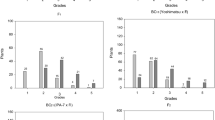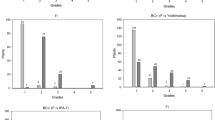Abstract
Tomato production in the Gangetic plains of eastern India is threatened by high incidence of bacterial wilt (BW) disease caused by Ralstonia solanacearum. Understanding the genetic control of tolerance through utilization of tolerant genotype is the prerequisite to frame effective resistant breeding strategy. Genetic control of host tolerance to BW disease was studied employing six generations (P1, P2, F1, F2, BC1, BC2) of two crosses between one tolerant (Utkal Kumari) and two susceptible (CLN-2498D and CLN-2777F) genotype(s) in presence of the predominant virulent strain (Biovar IIIA) of Ralstonia solanacearum through χ2 test and generation mean analysis. It emerged that tolerance to BW disease was conditioned predominantly by single dominant gene in two Tolerant × Susceptible crosses however, significance of scaling tests revealed involvement of duplicate epistasis suggesting somewhat complex inheritance pattern for the tolerance. Area under disease progress-curve (AUDPC) suggested that cumulative disease progress was less in tolerant genotypes of segregating generations. Duplicate epistasis controlling BW disease incidence suggested mild selection intensity in earlier generation, while intense in later generations of the segregating population in tomato. In this situation, modified bulk method of selection is recommended, in which selection is performed after attaining the homozygosity for maximum heterozygous loci. However, development of hybrids involving at least one tolerant parent is the best option for breeding tomato against BW disease.




Similar content being viewed by others
References
Acharya Brati, Dutta Subhramalya, Dutta Subrata, Chattopadhyay Arup (2018) Breeding tomato for simultaneous improvement of processing quality, fruit yield, and dual disease tolerance. Intl J Veg Sci 24(5):407–423
Artal RB, Gopalakrishnan C, Thippeswamy B (2012) An efficient inoculation method to screen tomato, brinjal and chilli entries for bacterial wilt resistance. Pest Manag Hort Ecosyst 18(1):70–73
Ashmawy NA (2015) Detection and molecular characterization of some Egyptian isolates of Ralstonia solanacearum by nested-PCR and PCR-RFLP analyses. Pl Path J 14:168–174
Aslam MN, Mukhtar T, Ashfaq M, Hussain MA (2017a) Evaluation of chili germplasm for resistance to bacterial wilt caused by Ralstonia solanacearum. Australas Plant Pathol 46(3):289–292
Aslam MN, Mukhtar T, Hussain MA, Raheel M (2017b) Assessment of resistance to bacterial wilt incited by Ralstonia solanacearum in tomato germplasm. J Plant Dis Prot 124(6):585–590
Bhutia ND, Seth T, Shende VD, Dutta S, Chattopadhyay A (2015) Estimation of heterosis, dominance effect and genetic control of fresh fruit yield, quality and leaf curl disease severity traits of chilli pepper (Capsicum annuum L.). Sci Hortic 182:47–55
Campbell CL, Madden LV (1990) Introduction to plant disease epidemiology. Wiley-Interscience, New York
Cellier G, Prior P (2010) Deciphering phenotypic diversity of Ralstonia solanacearum strains pathogenic to potato. Phytopatholgy 100:1250–1261
Chattopadhyay A, Dutta S, Bhattacharya I, Karmakar K, Hazra P (2007) Technology for Vegetable Crop Production. In: all Indian coordinated research project on vegetable crops. Nadia, West Bengal, Directorate of Research, Bidhan Chandra Krishi Viswavidyalaya. P. 226
Chattopadhyay A, Seth T, Dutta S, Ghosh PP, Chattopadhyay SB, Majumder D, Hazra P (2012) Breeding eggplant for higher yield and bacterial wilt tolerance. Int J Veg Sci 18(4):376–392
Dhall RK, Hundal JS (2006) Genetics of yield attributes in chilli (Capsicum annuum). Indian J Agric Sci 76:699–701
Fegan M, Prior P (2005) How complex is the Ralstonia solanacearum species complex? In: Allen C, Prior P, Hayward AC (eds) Bacterial wilt disease and the Ralstonia solanacearum species complex. APS Press, Saint Paul, MN, pp 449–461
Genin S (2010) Molecular traits controlling host range and adaptation to plants in Ralstonia solanacearum. New Phytol 187:920–928
Ghosh PP, Dutta S, Seth T, Chattopadhyay A (2015) Influence of stem and root vascular anatomy of eggplant germplasm on severity of vascular bacterial wilt disease. Indian Phytopathology 68:363–367
Gomez KA, Gomez AA (1984) Statistical procedures for agricultural research, 2nd edn. Willey, New York
Grimault V, Gélie B, Lemattre M, Prior P, Schmit J (1994) Comparative histology of resistant and susceptible tomato cultivars infected by Pseudomonas solanacearum. Physiol Mol Pl Path 44:105–123
Grimault V, Prior P, Anais G (1995) A monogenic dominant resistance of tomato to bacterial wilt in Hawaii 7996 is associated with plant colonization by Pseudomonas solanacearum. J Phytopathol 143:349–352
Grover A, Chakrabarti SK, Azmi W, Khurana SMP (2012) Rapid method for isolation of PCR amplifiable genomic DNA of Ralstonia solanacearum infested in potato tubers. Adv Microbiol 2:441–446
Hanson PM, Wang JF, Licardo O, Mah SY, Hartman GL, Lin YC, Chen JT (1996) Variable reaction of tomato lines to bacterial wilt evaluated at several locations in Southeast Asia. Hortscience 31:143–146
Hanson PM, Licardo O, Hanudin Wang JF, Chen JT (1998) Diallel analysis of bacterial wilt resistance in tomato derived from different sources. Pl Dis 82:74–78
Hasanuzzaman M, Golam F (2011) Gene actions involved in yield and yield contributing traits of chilli (Capsicum annuum L.). Aust J Crop Sci 5:1868–1875
Hayward AC (1964) Characteristics of Pseudomonas solanacearum. J Appl Bacteriol 27:265–277
Hayward AC (1991) Biology and epidemiology of bacterial wilt caused by Pseudomonas solanacearum. Annu Rev Phytopathol 29:65–87
Hazra P, Chattopadhyay A, Karmakar K, Dutta S (2011) Modern Technology in Vegetable Production (eds.). New India Publishing Agency, New Delhi, India, p 480
He LY, Sequeira L, Kelman A (1983) Characteristics of strains of Pseudomonas solanacearum from China. Pl Dis 67:1357–1361
Hildebrand DC, Schroth MN, Sands DC (1988) Laboratory guide for identification of plant pathogenic bacteria. In: Schaad NW(ed) Pseudomonas. The American Phytopathological Society, St. Paul, Minnesota, pp 60–81
Huang Q, Allen C (1997) Exo-poly-a-D-galacturonidase, PehB, is required for wild-type virulence of Ralstonia solanacearum. J Bacteriol 179:7369–7378
Ishihara T, Mitsuhara I, Takahashi H, Nakaho K (2012) Transcriptome analysis of quantitative resistance-specific response upon Ralstonia solanacearum infection in tomato. PLoS One 7:e46763
Janse J, Beld D, van Den H (2004) Introduction to europe of Ralstonia solanacearum biovar 2, race 3 in Pelargonium zonale cuttings. J Pl Path 86:147–155
Kearsey MJ, Pooni HS (1996) The genetic analysis of quantitative traits, 1st edn. Chapman and Hall, London
Kelman A (1954) The relationship of pathogenicity in Pseudomonas solanacearum to colony appearance on a tetrazolium medium. Phytopathology 44:693–695
Lebeau A, Daunay MC, Frary A, Palloix A, Wang JF, Dintinger J (2011) Bacterial wilt resistance in tomato, pepper, and eggplant: genetic resources respond to diverse strains in the Ralstonia solanacearum species complex. Phytopathology 101:154–165
Lelliott RA, Stead DE (1987) Methods for the diagnosis of bacterial disease of plants, 2nd edn. Blackwell Scientific Publications, Oxford, UK, British Society for Plant Pathology, p 216
Mahir AM, Ismail A, Diong KS (1993) Virulence studies of Pseudomonas solanacearum and inheritance of resistance in Lycopersicon esculentum. ACIAR Proc 45:154–157
Mane, RS (2013) Genetic studies of yield and its component traits and identification of molecular markers linked to bacterial wilt resistance in tomato (Solanum lycopersicum L.). Ph.D. Thesis. University of Agricultural Sciences, Dharwad, India
Mather K (1949) Biometrical genetics. Mathuen and Co., Ltd., London
Mather K, Jinks JL (1982) Biometrical genetics, 3rd edn. Chapman and Hall Ltd., London
Mondal B, Bhattacharya I, Khatua DC (2014) Incidence of bacterial wilt disease in West Bengal, India. Acad J Agric Res 2(6):139–146
Monma S, Narikawa T, Sakata Y, Hida K (1993) Resistance to bacterial wilt in tomato cultivars [in Japanese with English summary]. Bull Natl Res Inst Veg Ornam Plants and Tea A6:1–12
Monma S, Sakata Y, Matsunaga H (1997) Inheritance and selection efficiency of bacterial wilt resistance in tomato. Japan Agric Res Quart 31:195–204
Oliveira WF, Giodano LB, Lopes CA (1999) Inheritance of resistance to bacterial wilt in tomato. Fitopatol Bras 24:49–53
Opena RT, Green SK, Talekar NS, Chen JT (1990) Genetic improvement of tomato adaptability to the tropics. In: Green SK, Griggs T, McLean BT (eds) Tomato and pepper production in the tropics. Asian Vegetable Research and Development Center, Tainan, Taiwan, pp 70–85
Panse VG, Sukhatme PV (1978) Statistical methods for agricultural research workers. ICAR, New Delhi
Peter KV, Gopalakrishnan TR, Rajan S, Sadhan Kumar PG (1992) Breeding for resistance to bacterial wilt in tomato, eggplant and pepper, In: Hayward AC, Hartman GL, Harmon GL (eds) Bacterial wilt (ACIAR Proceedings), State Mutual Book and Periodical Service, Kaohsiung, Taiwan, pp. 183–190
Roy A, Acharyya S, Das S, Ghosh R, Paul S, Srivastava RK, Ghosh SK (2009) Distribution, epidemiology and molecular variability of the begomovirus complexes associated with yellow vein mosaic disease of mesta in India. Virus Res 141:237–246
Schaad NW, Jones JB, Chun W (2001) Laboratory guide for identification of plant pathogenic bacteria, 3rd edn. APS press, St. Paul, USA
Scott JW, Somodi GC, Jones JB (1988) Bacterial spot resistance is not associated with bacterial wilt resistance in tomato. Proc Fl St Hort Soc 101:390–392
Seal SE, Jackson LA, Young JPW, Daniels MJ (1993) Differentiation of Pseudomonas solanacearum, Pseudomonas syzygii, Pseudomonas picketti and the blood disease bacterium by partial 16S rRNA sequencing: construction of oligonucleotide primers for sensitive detection by polymerase chain reaction. J Gen Microbiol 139:1587–1594
Thakur AK, Kohli UK, Kumar M (2004) Inheritance of resistance to bacterial wilt in tomato. Indian J Genet 64:79–80
Tikoo SK, Anand N, Kirishna R (1983) Presence of two independent genetic systems for resistance to bacterial wilt (Pseudomonas solanacearum). 15th international congress of genetics, 22-23 December, 1983, New Delhi
Villareal RL, Lai SH (1978) Reaction of three tomato cultivars their F1’s and three way crosses to two isolates of bacterial wilt. HortScience 13:366
Williamson L, Hudelson BD, Allen C (2002) Ralstonia solanacearum isolates isolated from geranium belong to race 3 and are pathogenic on potato. Pl Dis 86:987–991
Winstead NN, Kelman A (1952) Inoculation technique for evaluating resistance to Pseudomonas solanacearum. Phytopathology 42:628–634
Acknowledgements
The authors would like to thank AVRDC, Taiwan and OUAT, Bhubaneswar, Odisha, India for providing genetic materials to conduct this research.
Author information
Authors and Affiliations
Corresponding author
Rights and permissions
About this article
Cite this article
Acharya, B., Ghorai, A.K., Dutta, S. et al. Genetics of tolerance to bacterial wilt disease in tomato (Solanum lycopersicum L.). Australasian Plant Pathol. 47, 591–600 (2018). https://doi.org/10.1007/s13313-018-0601-9
Received:
Accepted:
Published:
Issue Date:
DOI: https://doi.org/10.1007/s13313-018-0601-9




